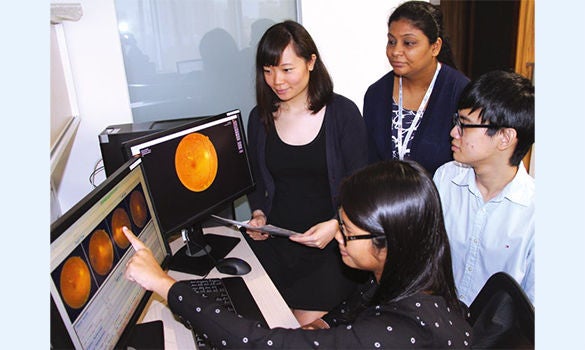
(SiDRP) by SNEC Ocular Reading Centre
Singapore Integrated Diabetic Retinopathy Programme (SiDRP) by SNEC Ocular Reading Centre
Diabetic Retinopathy (DR) is a disorder of the blood vessels in the retina of patients with diabetes mellitus. It is the leading cause of new blindness in working adults in developed countries, including Singapore.
Diabetic Retinopathy first manifests itself slowly over the years as background retinopathy, which is the early stage of DR. At this early stage, tiny blood spots or fatty deposits appear on the retina.
Proliferative retinopathy develops from background retinopathy and is responsible for most of the visual loss in diabetics.
In this condition, new blood vessels grow on the surface of the retina and optic nerve. These immature blood vessels tend to rupture and bleed into the cavity of the eye.
Scar tissue can also form from the ruptured blood vessels and can contract and pull on the retina, causing retinal detachment and vision loss. In some cases, new vessels can grow on the iris and cause a form of glaucoma, which itself can lead to blindness.
The Singapore Integrated Diabetic Retinopathy Programme is offered by the SNEC Oculus Reading Centre (SORC) to conduct eye screening of diabetic patients. To date, SORC has assessed more than 150,000 eye screenings from diabetic patients in more than 20 centres islandwide, under SiDRP.
The SiDRP is based on a ‘real time’ assessment of DR, from photographs by a centralised team of accredited trained readers, supported by a tele-ophthalmology IT infrastructure.
Two-field images are taken using a retina camera and sent to the reading centre. The images are reviewed by trained readers, who generate the reports within a day (often within the hour).
The reports are sent to the patient’s doctor, who will refer the patient to an ophthalmologist, if necessary. Audit checks are conducted regularly, and our recent results showed 90% sensitivity and specificity, when measured against an ophthalmologist.
The improvements to the traditional DR screening process include better accuracy in reporting1, increase in patient satisfaction due to shorter turnaround time to receive a report, and that doctors can now spend more time on the management and care of the patient.
Our recent cost-effectiveness study2 also found that the cost-savings attributed by using an SiDRP model is estimated to be $144 per person. Extrapolating to the entire polyclinic diabetic population, the savings would be $29.4 million over a lifetime horizon.
Our clients include GP clinics, SingHealth Polyclinics, Family Medicine Centres (FMC), Community Health Centres (CHC), hospitals, health screening centres, VWOs, and optical shops.
SNEC OCULAR READING CENTRE
The SNEC Ocular Reading Centre (SORC), established in 2006, provides evaluation and interpretation (grading) services of ocular pathology from fundus photographs, fluorescein angiograms, Optical Coherence Tomography (OCT) scans or other imaging modalities, using advanced and standardised grading protocols.
Started as a research unit, SORC has evolved into a clinical service and serves as a tele-ophthalmic occular reading centre. It is a hub that ensures effective and prompt service delivery by streamlining and automating the entire process; from image capture on site, to the electronic transfer of the image via a dedicated conduit to the reading centre.
In July 2010, the Singapore Integrated Diabetic Retinopathy Programme (SiDRP) was rolled-out with aims to improve on the traditional Diabetic Retinopathy (DR) screening, where patients with diabetes undergo annual retinal photography for an assessment of DR, using a non-standardised protocol by family physicians with a turnaround time for reports that took 2 - 3 weeks.

For more information, please contact:
SNEC Ocular Reading Centre
Ms Soundaram Jaganathan
Assistant Manager
Tel:
6576 7212
Email: soundaram.jaganathan@snec.com.sg
Website: https://www.snec.com.sg/clinicalservices/Pages/SNECOcularReadingCentre.aspx
References
1. Bhargava M, Cheung CY, Sabanayagam C, et al. Accuracy of diabetic retinopathy screening by trained non-physician graders using non-mydriaticfundus camera. Singapore Med J. 2012;53(11):715-719.
2. Nguyen HV, Tan GS, Tapp RJ, et al. Cost-effectiveness of a national telemedicine diabetic retinopathy screening programme in Singapore. Ophthalmology.016;123(12):2571-2580













 Get it on Google Play
Get it on Google Play